NEEP602 Course Notes (Fall 1996)
Resources from Space
 Mercury
Mercury
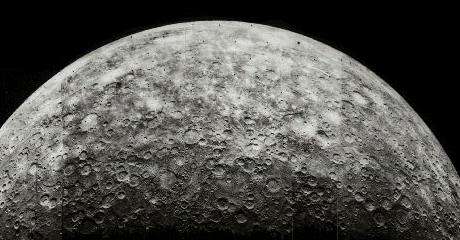
Mercury Facts
- Mercury is the closest planet to the Sun and the eighth largest:
- average distance from Sun: 57,910,000 km (0.38 AU)
- diameter: 4,878 km
- mass: 3.30e23 kg
- density: 5.43 gm/c
- In Roman mythology Mercury is the god of commerce and thievery, the
Roman counterpart of the Greek god
Hermes,
the messenger of the Gods..
- Mercury has been visited by only one spacecraft,
Mariner 10.
It flew by three times in 1973 and 1974. Only 45% of the surface
was mapped (picture 1, above).
- Mercury's orbit
is highly eccentric; at
perihelion it is only 46 million km from
the Sun but at aphelion it is 70 million.
The perihelion of its orbit
precesses around the Sun at a very slow rate.
- Until 1962 it was thought that Mercury's "day" was the same length as its "year"
so as to keep that same face to the Sun much as the Moon
does to the Earth. But this was shown to be false in 1965 by doppler
radar observations. It is now known that Mercury rotates three times in two of
its years.
Mercury is the only body in the solar system known to be captured
in a ratio other than 1:1.
- Temperature variations on Mercury are the most extreme in the solar system
ranging from 90 K to 700 K. The temperature on
Venus is slightly hotter but very stable.
- Mercury is in many ways similar to the Moon:
its surface is heavily cratered (picture 5) and very
old;
it has no atmosphere; it exhibits no
plate tectonics.
On the other hand, Mercury is much denser than the Moon (5.43 gm/cm3 vs 3.34).
Mercury is the second
densest major body in the
solar system, after Earth. Actually Earth's density is
due in part to gravitational compression; if not for this, Mercury would be
denser than Earth.
This indicates that Mercury's dense iron core is
relatively larger than Earth's, probably comprising
the majority of the planet. Mercury therefore has only a relatively thin
silicate mantle and crust.
- Mercury's interior is dominated by a large iron core whose radius is 1800 to 1900
km. The silicate outer shell (analagous to Earth's mantle and crust)
is only 500 to 600 km thick. At least some of the core is probably molten.
- The surface of Mercury exhibits enormous escarpments, some up to hundreds of
kilometers in length and as much as three kilometers high
(picture 9). Some cut thru the rings
of craters and other features in such a way as to indicate that they were formed
by compression. It is estimated that the surface area of Mercury shrank by about
0.1% (or a decrease of about 1 km in the planet's radius).
- One of the largest features on Mercury's surface is the Caloris Basin
(picture 2); it is about 1300 km in diameter.
It is thought to be similar to the large
basins (maria) on the Moon. Like the lunar basins, it
was probably caused by a very large
impact early in the history of the solar system.
That impact was probably also responsible
for the odd terrain on the exact opposite side of the planet
(picture 4).
- In addition to the heavily cratered terrain, Mercury also has regions of
relatively smooth plains. Some may be the result of ancient volcanic activity
but some may be the result of the deposition of ejecta from cratering impacts.
- There is no evidence of recent volcanism on Mercury.
- Amazingly, radar observations of Mercury's north pole (a region
not mapped by Mariner 10) show evidence of water ice in the protected
shadows of some craters.
- Mercury has a small magnetic field whose strength is about 1% of Earth's.
- Mercury has no known satellites.
- Mercury is sometimes visible with binoculars or even the naked eye, but it is always very near the Sun and difficult to see in the twilight sky. Mike Harvey's planet finder charts show the current position of Mercury (and the other planets) in the sky.
Pictures
- (above) Mosiac of photos taken from Mariner 10 in 1974
16k jpg;
110k gif
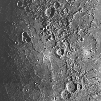 Caloris Basin
319k gif;
238k jpg;
108k jpg
Caloris Basin
319k gif;
238k jpg;
108k jpg
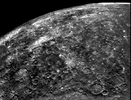 Southwest Mercury
31k jpg;
1000k gif;
488k gif
Southwest Mercury
31k jpg;
1000k gif;
488k gif
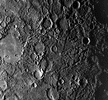 Hills of Mercury
127k jpg;
185k jpg;
614k gif
Hills of Mercury
127k jpg;
185k jpg;
614k gif
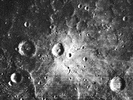 Mercury Close Up
31k jpg
Mercury Close Up
31k jpg
- another mosaic 24k jpg
- yet another mosaic
44k jpg
 Mosaic of the Discovery quadrangle of Mercury
73k jpg
Mosaic of the Discovery quadrangle of Mercury
73k jpg
- Close up of Discovery Rupes 34k jpg
- south polar mosaic 335k gif
- ... more Mercury images
More about Mercury
- from ASU
- from LANL
- from JPL
- from RPIF
- from RGO
- from NSSDC
- from NASA Spacelink
- Dr. Cain's class notes
- Mercury Nomenclature Table
Open Issues
- Mercury's density (5.43 gm/cm3) is nearly as high as Earth's. Yet in most other respects it more closely resembles the Moon. Did it lose its light rocks in some early catastrophic impact?
- What processes produced Mercury's smooth plains?
- Are there any surprises on the other 1/2 of the surface we've not seen? Low resolution radar images obtained from Earth show no surprises, but you never know.
- Recently a proposal for two new Mercury missions has been put forward to fly in 1999.
Bill Arnett; original source: 1996 January 18
Revised for 602/376 by R. P. Meyer, February 19, 1996
 |
|
University of Wisconsin Fusion Technology Institute · 439 Engineering Research Building · 1500 Engineering Drive · Madison WI 53706-1609 · Telephone: (608) 263-2352 · Fax: (608) 263-4499 · Email: fti@engr.wisc.edu |
Copyright © 2003 The Board of
Regents of the University of Wisconsin System.
For feedback or accessibility issues, contact
web@fti.neep.wisc.edu.
|
